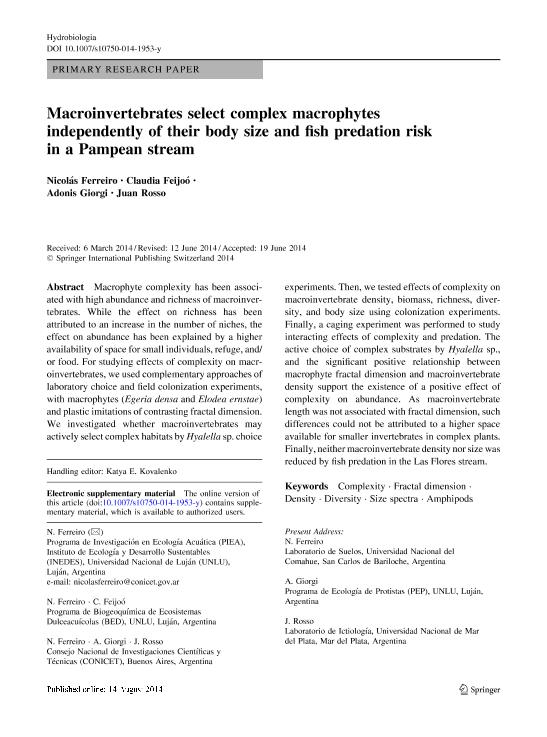Mostrar el registro sencillo del ítem
dc.contributor.author
Ferreiro, Nicolas Andres

dc.contributor.author
Feijoó, Claudia Silvina

dc.contributor.author
Giorgi, Adonis David Nazareno

dc.contributor.author
Rosso, Juan Jose

dc.date.available
2017-01-26T19:28:57Z
dc.date.issued
2014-07
dc.identifier.citation
Ferreiro, Nicolas Andres; Feijoó, Claudia Silvina; Giorgi, Adonis David Nazareno; Rosso, Juan Jose; Macroinvertebrates select complex macrophytes independently of their body size and fish predation risk in a Pampean stream; Springer; Hydrobiologia; 740; 1; 7-2014; 191-205
dc.identifier.issn
0018-8158
dc.identifier.uri
http://hdl.handle.net/11336/12003
dc.description.abstract
Macrophyte complexity has been associated with high abundance and richness of macroinvertebrates. While the effect on richness has been attributed to an increase in the number of niches, the effect on abundance has been explained by a higher availability of space for small individuals, refuge and/or food. For studying effects of complexity on macroinvertebrates we used complementary approaches of laboratory choice and field colonization experiments, with macrophytes (Egeria densa and Elodea ernstae) and plastic imitations of contrasting fractal dimension. We investigated whether macroinvertebrates may actively select complex habitats by Hyalella sp. choice experiments. Then, we tested effects of complexity on macroinvertebrate density, biomass, richness, diversity and body size using colonization experiments. Finally, a caging experiment was performed to study interacting effects of complexity and predation. The active choice of complex substrates by Hyalella sp., and the significant positive relationship between macrophyte fractal dimension and macroinvertebrate density supports the existence of a positive effect of complexity on abundance. As macroinvertebrate length was not associated with fractal dimension, such differences could not be attributed to a higher space available for smaller invertebrates in complex plants. Finally, neither macroinvertebrate density nor size were reduced by fish predation in the Las Flores stream.
dc.format
application/pdf
dc.language.iso
eng
dc.publisher
Springer

dc.rights
info:eu-repo/semantics/openAccess
dc.rights.uri
https://creativecommons.org/licenses/by-nc-sa/2.5/ar/
dc.subject
Complexity
dc.subject
Fractal Dimension
dc.subject
Density
dc.subject
Diversity
dc.subject
Size Spectra
dc.subject
Amphipods
dc.subject.classification
Ecología

dc.subject.classification
Ciencias Biológicas

dc.subject.classification
CIENCIAS NATURALES Y EXACTAS

dc.title
Macroinvertebrates select complex macrophytes independently of their body size and fish predation risk in a Pampean stream
dc.type
info:eu-repo/semantics/article
dc.type
info:ar-repo/semantics/artículo
dc.type
info:eu-repo/semantics/publishedVersion
dc.date.updated
2016-12-12T14:30:52Z
dc.journal.volume
740
dc.journal.number
1
dc.journal.pagination
191-205
dc.journal.pais
Alemania

dc.journal.ciudad
Berlín
dc.description.fil
Fil: Ferreiro, Nicolas Andres. Consejo Nacional de Investigaciones Científicas y Técnicas. Centro Científico Tecnológico Patagonia Norte. Instituto de Investigación En Biodiversidad y Medioambiente; Argentina. Universidad Nacional de Lujan. Instituto de Ecologia y Desarrollo Sustentable; Argentina. Universidad Nacional del Comahue; Argentina
dc.description.fil
Fil: Feijoó, Claudia Silvina. Universidad Nacional de Luján; Argentina
dc.description.fil
Fil: Giorgi, Adonis David Nazareno. Universidad Nacional de Lujan; Argentina. Consejo Nacional de Investigaciones Científicas y Técnicas; Argentina
dc.description.fil
Fil: Rosso, Juan Jose. Consejo Nacional de Investigaciones Científicas y Técnicas; Argentina. Universidad Nacional de Mar del Plata; Argentina
dc.journal.title
Hydrobiologia

dc.relation.alternativeid
info:eu-repo/semantics/altIdentifier/url/http://link.springer.com/article/10.1007/s10750-014-1953-y
dc.relation.alternativeid
info:eu-repo/semantics/altIdentifier/doi/http://dx.doi.org/10.1007/s10750-014-1953-y
Archivos asociados
